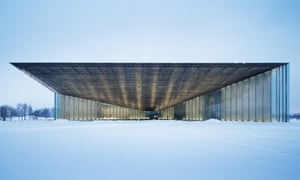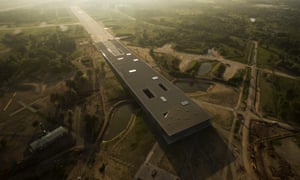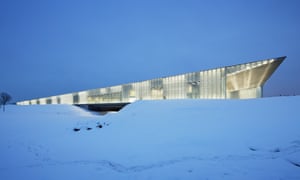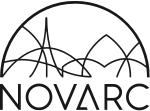
It is unusual to put a museum at the end of a runway, still more if it also straddles a chain of ornamental lakes, but then the Estonian National Museum is not a usual sort of institution. Its past is wrapped up with that of the country itself. Now it somehow has to represent the complex and precarious history of Estonia, in a fraught present, with a combination of pride and sensitivity.
For a European country to build a national museum at this moment, when nationalism is taking new and unpredictable forms, is perilous. If Russia were to invent such a thing now, it would look like another form of aggressive aggrandisement; if Britain, an episode of querulous post-Brexit blue-passport patriotism; if Germany, it would raise issues too agonising for a single museum to handle. Estonia, a country of 1.3 million, whose two periods of independence – between the wars and since 1991 – add up to less than 50 years, and which still has grounds to be nervous of its neighbour Russia, has reason to define and assert itself with a museum, but it also has to tread cautiously.
The idea of a national museum has been linked to the idea of Estonian independence for more than a century, ever since a group of nationalist-minded intellectuals decided to create such a thing. Since then the fluctuating fortunes of independence, war and occupation have caused the collections to be housed in different places, to be dispersed and reassembled. Under postwar Soviet occupation the contents and concept of the museum were threatened. In the late 80s the call to reinstate the museum was part of a new campaign for freedom. The new €70m building is the fulfilment of this desire, after many years of debate and interruptions since Estonia won back independence in 1991.
Its location, according to the usual logic of maximising visitor numbers, is near-suicidal. It is not in the capital Tallinn but 190km away in the second city, Tartu (population 100,000), and not precisely there either but a 2km journey through sometimes brutal weather from the centre. But what the site lacks in accessibility it makes up for in significance: it includes the remains of a manor house, wrecked in 1944, in which the collections were housed between the wars. It also includes an airstrip, with associated earthworks for protecting warplanes, used by the Soviet military. With the aircraft roaring over the ancient university town of Tartu, it was a symbol of the hatefulness of occupation.
The design of the building is the result of a competition held in 2005 and won by a multinational trio of young architects, the Italian-Israeli Dan Dorell, the Lebanese Lina Ghotmeh and the Japanese Tsuyoshi Tane, who were working in the London offices of David Adjaye and Norman Foster and sacrificing sleep and leisure to work on their entry in their spare time. Entrants could choose a site somewhere in the grounds of the old manor house. DGT (as the three called themselves once they became an architectural practice) selected a location at the end of the old runway. For the architects it was important not to erase the past – that as Dorell says, the museum could be “mature enough to get over the trauma”.

The building, 355m long, projects the straight lines of the runway back towards the city. Its glass sides, imprinted with a white pattern, are designed to reflect surrounding trees and snow. Its roof gradually slopes upwards until it forms a grand portico at the main entrance. At one point the building bridges a lake, one of a sequence that originated in the manor house’s landscape garden. Courtyards puncture the block, introducing fragments of nature. The interior is spacious and airy, with views to the outside seen through layers of glass.
It was a controversial choice, to draw attention to the most negative part of the site’s history. There were also strong lobbies for placing the museum somewhere else entirely, in the centre of Tartu or in Tallinn. The European Union, not liking the remote location, refused to contribute to its cost. There were objections to the appointment of foreign architects for this national emblem. The 2008 crash slowed things down.
For all these reasons it took more than a decade for the designs to be realised, during which time DGT set up their office and based themselves in Paris, all the time battling to realise what would be a spectacular first project for any practice, working unpaid when necessary – “we were ready for anything to make this happen”. They credit the “miracle” of its realisation to its former director Krista Aru – “to the strength of that woman” – and to “our belief”.
The outcome is a contrasting combination of national and international, folkloric and modern, charged and cool. The building is glassy, geometric, hard-surfaced, straight-lined. The contents tend to be handmade, everyday, sometimes rough-hewn, often in the country’s most abundant material, which is wood. The aim of the museum is not to record grand historical events so much as the lives that ordinary people lived through them. Nor is it just about exhibits – music and drama are held there, such that the museum becomes in effect a very large village hall.
The origins of the collection are in the late 19th and early 20th centuries, when 1,400 volunteers toured the towns and villages of the not-yet-recognised country to gather texts and artefacts of popular folklore. To these have been added mementoes of lives since then, through the turbulence of the 20th century. There are for example the charms, pagan in origin, that peasants used to bring luck to their fields centuries after the country was supposedly Christianised. There are 2,600 ornamental wooden beer tankards, large and individually personalised. There are medals won by pilots, an art deco radio, rusted military material from the airfield, early photographs of cautiously squinting country people.
Struggles against foreign rule – the country has at different times been run by Swedes, Germans and Russians – are there, but mostly discreetly. There is a video of the Baltic Way of 1989, in which 2 million people joined hands across the three Baltic states of Estonia, Latvia and Lithuania. There is a bookcase that reconstructs the way in which, under the Soviets, cohesion came from oppression: restricted in many ways, Estonians turned to discussions of literature, in turn limited by the small range of titles available, which were mostly translations of classics such as Dickens. There is a lawnmower from a time when it was impossible to buy such a machine, a little monument of persistence and ingenuity, handmade out of a pushchair, a washing machine motor and a bucket.

The patriotism is a little more overt in a reverential room in which the first Estonian flag, made by students in the late 19th century and banned in Soviet times, is displayed. There are also large basement galleries dedicated to the peoples deep in Russia who speak languages in the same Finno-Ugric group as Estonian, a partly conjectural display of festivals and reconstructed cabins. This is tricky stuff, not least for the large Russian minority within Estonia, but it is mostly negotiated with tact.
The museum could be both triumphalist and sentimental, but it is neither. At their best the displays are touching and revealing rather than heroic. The architecture plays its part by combining the drama of its setting and a striking overall form with a deadpan delivery. Views are offered of the ruin and of the landscape, downward to water and upward to sky, and long perspectives to the runway, but without exclamation marks. The temptation to invent a style somehow Baltic-looking has been avoided.
If these are good instincts they also mean that the building, contents and setting will take some getting used to each other. It is a long way from the contemporary sharpness of the glass to a wooden beer tankard, a distance that the designers of the exhibition installations have tried too hard and intrusively to close. The surrounding landscape, much of which had to be dug up to remove contamination left by the airbase, is still raw.
The museum is a project unlikely as the lawnmower, or indeed Estonia itself, which relies on passion for the theme to override disadvantages of location. So far it seems to be working, with about 60,000 visitors in each of its first two months. It is also a work in progress, not least because the museum is still inviting Estonians to contribute their personal objects. This is as it should be, as identity is something that never stands still.
Rowan Moore
The Guardian
The Observer / Architecture
